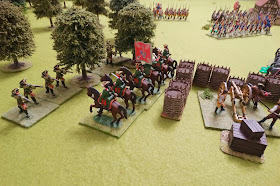 |
| At this time of year, it's easy to find a quiet corner in the delightful grounds of Blenheim Palace. |
Well, what a fool I've been. Since I moved to my present job 6 years ago I've visited Blenheim Palace many times. How did I miss the diorama of the battle in the museum area, with its thousands (yes, thousands) of 6mm miniatures? Whilst kicking myself and admiring the work, what did I see in the bottom right hand corner but the nameplate in the photo below:
 |
| Hmmm. I seem to recognise that name... |
Yes indeed, the Charles Wesencraft. Wanting to know some background, I did what one does these days and searched the internet - which duly came to my aid. The diorama was created in 2003-4 almost entirely just by the man himself for the 300th anniversary of the battle. That's 6000 6mm Baccus figures painted by one man in well under a year. Crikey. He tells the story HERE.
 |
| The battle is depicted as it was at 5.15pm. This is Oberglau, viewed from behind the British lines. |
 |
| Blindheim/Blenheim assaulted by the British. |
 |
| A close up of some of the cavalry figures. |
 |
| Oberglau again and the cavalry contest to the west. |
Intentions must have changed since the display was installed, as it has remained in the historical exhibition located in the old stables, and has not moved to the palace as Charles mentions in his story.
A further treat is in store for anyone hanging around outside the gents toilets (as I often do; it's all entirely legal you know). But let me put it another way. In the lobby area outside the rest rooms there is a fine display of models from the National Collection of the British Model Soldier Society. My photo shows figures from the wars of the 18th century. Some beautifully painted flats can be seen on the lower shelf. Surprisingly, many people seem to hurry past without even noticing the treasures on display!
A further treat is in store for anyone hanging around outside the gents toilets (as I often do; it's all entirely legal you know). But let me put it another way. In the lobby area outside the rest rooms there is a fine display of models from the National Collection of the British Model Soldier Society. My photo shows figures from the wars of the 18th century. Some beautifully painted flats can be seen on the lower shelf. Surprisingly, many people seem to hurry past without even noticing the treasures on display!
Anyway, if you've never looked into it, Blenheim Palace is a fantastic visit on many levels - as the birthplace of Churchill, as a glorious piece of architecture, as the location of extensive and beautiful grounds which can be explored at will, and as an historic building linked to one of the most famous battles in history. Visit if you can, and allow all day.
I'll be back with some wargamey stuff, asap!



















